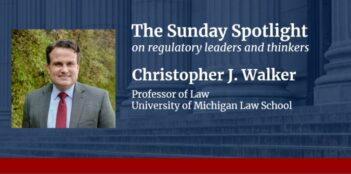
Top regulatory practitioners from the Volcker Alliance lay out keys to regulatory excellence.
Regulators get a bad rap. During times of crisis, they are criticized for failing to do their job. Yet even during periods of tranquility, they are often skewered for regulating too much. Given this dilemma, how do regulators know when they are doing a good job? Better yet, what makes a regulator not just good, but excellent?
For Shelley Metzenbaum and Gaurav Vasisht, the core of regulatory excellence lies in the regulator’s ability to further its mission. In their chapter of the recent book, Achieving Regulatory Excellence, Metzenbaum and Vasisht argue that an excellent regulator “is one that is adequately funded, that wisely manages its resources, and that effectively navigates its external relationships so as to act even under difficult circumstances for the purpose of furthering its mission.”
Metzenbaum, the former President of The Volcker Alliance, and Vasisht, the Director of Financial Regulation at The Volcker Alliance, observe that legislators often specify an agency’s mission by statute. For example, the Federal Reserve System’s mandate is to provide “the nation with a safer, more flexible, and more stable monetary and financial system.” But sometimes legislators do not clearly specify a regulatory agency’s mission, or they do so only in general terms—and in those cases, it is up to the agency to define its intended mission.
The key, Metzenbaum and Vasisht contend, is that “excellent organizations translate their mission into specific goals, objectives, strategies, and suites of indicators which they use to gauge progress on achieving their missions and to know when mid-course corrections are needed.”
In setting goals, however, Metzenbaum and Vasisht caution that regulators must be careful not to scope goals too narrowly nor introduce perverse incentives. They warn against setting goals so specific that regulators neglect other important objectives. In addition, they observe that “linking incentives to goal attainment” can sometimes lead to “measurement manipulation.” For example, in some instances when students’ test scores have been linked to a teacher’s performance for purposes of reward or punishment, some teachers reportedly have been tempted to teach to the test or, even worse, to cheat “to help students get better test scores.”
Still, choosing and managing to advance well-framed outcomes-focused goals enable an organization to keep up with innovation, they explain. Citing the 2008 financial crisis, Metzenbaum and Vasisht discuss how innovation within capital markets—markets that facilitate the purchase and sale of equity and debt—created risk that “could spill over into the broader financial system.” To address evolving risks in the market, Metzenbaum and Vasisht ask whether the U.S. Securities and Exchange Commission should seek to expand its mission of investor protection to include financial stability, or whether the Federal Reserve should look to expand its reach into the capital markets. They use these questions not to suggest a policy position but to illustrate the need for continuing adaptability in regulation.
Even with clear and specific goals, however, regulators still need adequate resources if they are to achieve excellence. When less is not enough, the concept of “doing more with less” can devastate a regulator’s ability to accomplish core missions, accumulate expertise, and foster a positive agency culture, Metzenbaum and Vasisht say. They cite the words of former U.S. Department of the Treasury Secretary Jack Lew, who said that “even with the best rules, effective supervision and enforcement are only possible with sufficient resources.”
Yet even when regulators do receive adequate funding, their resources must “be effectively managed,” Metzenbaum and Vasisht acknowledge. Once an agency has an appropriate level of funding, it must set priorities because “no agency has infinite resources.” Metzenbaum and Vasisht observe that most agencies generally have two key missions: (1) “improving (or preventing the deterioration of) conditions” that damage “complex systems” such as the financial system and the environment; and (2) “reducing the frequency and consequence of harmful incidents,” such as bank collapses and environmental disasters.
To fulfill these missions, regulators need to understand the entities they regulate. Without knowledge of what is happening inside an industry, regulators can easily overlook key risks, such as those that led to the 2008 financial crisis. To set meaningful priorities, regulators must “understand the business models and institutional risk profiles and vulnerability of those it regulates,” Metzenbaum and Vasisht warn. By learning more about the industry it regulates, a regulatory agency may be able to anticipate future issues and prioritize actions to mitigate risk. In addition, regulators must assess their own risk profile, and take the preparatory actions needed to prevent, minimize, and appropriately respond to internal risks that arise.
Mastering the business of regulating—setting goals, securing and managing resources, establishing and executing needed risk-reduction strategies—is not enough, however. A regulator must also be able to communicate expectations, accomplishments, and challenges effectively to the outside world, Metzenbaum and Vasisht argue. Regulators should “prioritize communication with regulated industries to restore the element of predictability and expectation, which may otherwise be lost in the process.” Furthermore, Metzenbaum and Vasisht say that because “public views about regulators are often biased toward the negative,” and because the public lacks awareness of previously achieved regulatory accomplishments, regulators must also “master the science and art of communications” to enhance public awareness.
In the end, Metzenbaum and Vasisht conclude that “regulatory leaders must not fear taking on challenges nor hesitate to let others receive some of the credit for their good work.” Despite expected criticism from the public, regulators should not let the fear of getting a bad rap stand in the way of their pursuit of excellence, they assert.
Metzenbaum and Vasisht’s chapter appears in the new book, Achieving Regulatory Excellence, which was edited by University of Pennsylvania Law School Professor Cary Coglianese, who founded and directs the Penn Program on Regulation.
This essay is part of a ten-part series, entitled In Pursuit of Regulatory Excellence.



